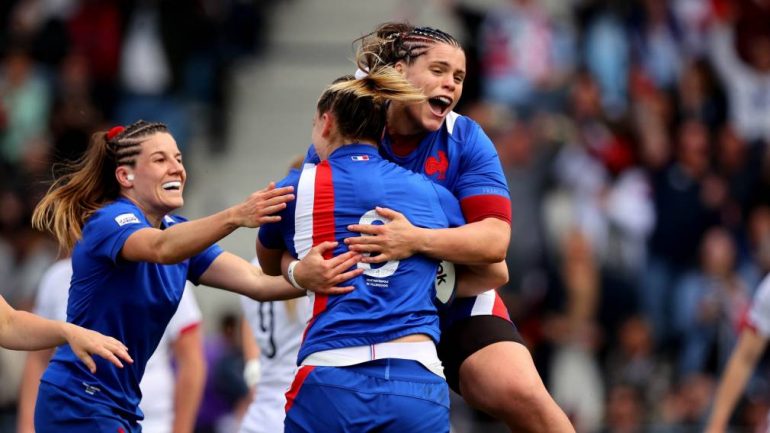Everything points to the most exciting end to a Six Nations tournament ever. Here’s a first glance at the coming crunch and its background.
This is how the table looks after four rounds:
Table W L Pts
England 4 0 20
France 4 0 19
Wales 2 2 10
Scotland 1 3 5
Italy 1 3 4
Ireland 0 3 0
The WXV
The approach of the new WXV means games on Super Saturday gain extra significance. Tussles at the lower end of the table will carry just as much importance for the contestants as at the top.
Wales need one more point to ensure entry to Tier 1. Scotland have a far inferior points difference, so even if they beat Ireland and Wales lose in Italy, they would still be entering Tier 2. Italy’s loss to Scotland was a big blow for them.
Whoever finishes fifth will now face a play-off against Spain; this is a late adjustment to World Rugby’s regulations.
That leaves Ireland fated to join Tier 3 where they may well dominate the scene. But there will be no promotion/relegation for two years, so this is a long-term outlook.
Let’s take a first look at how the Crunch is shaping up
We’ll have the biggest gathering ever to watch a women’s rugby match. For the first time in six years, the clash between the super heavyweights, England and France, takes place at Twickenham in front of a crowd of over 50,000.
That previous game was breathtaking enough: England went 0-13 down before coming back to win 26-13. Similar drama seems inevitable.
Game Plans
Historically French play has hinged on the No 9. It still does. For England the No 10 has more glamour – think only of Jonny Wilkinson.
In Pauline Bourdon and Holly Aitchison we have two highly accomplished examples of the type.
As people were mourning the retirement of Laure Sansus, they were overlooking Bourdon’s proven prowess. As people were regretting the injury to Zoe Harrison, they were forgetting Aitchison’s all-round skills, not least in Sevens.
England
Among England’s concerns both Marlie Packer, newly installed as captain, and Hannah Botterman left the field injured in Cork. The medical team will be working flat out to restore them, but the fear is neither of them will make Round Five.
Central though Packer’s contribution always is, Botterman’s absence may prove more concerning; England have been shorn of a number of props over the past year. Still missing are Vickii Cornborough, Laura Keates, Bryony Cleall and Detysha Harper. Still in the reckoning, we hope, are Maud Muir and Mackenzie Carson. But Muir has recently been playing at tight-head. She can switch across, but it’s asking a lot of a player facing the power of the current French pack.
My guess at present (24 April) is a front-row of Muir, Lark Davies and Sarah Bern.
The back row is better off. We could imagine a trio of Alex Matthews, Sadia Kabeya and Sarah Beckett (or Morwenna Talling, relatively inexperienced there). The need to play Beckett at lock in Cork shows how stretched resources are.
Of course it’s possible that others on the injury-list will have recovered in time. English fans will hope so.
In the recent past Simon Middleton has had recourse to calling a player out of the Premier 15s to help in emergency. She is Delaney Burns. It would be a mischievous irony if he had to call up another player from outside his squad of 42 for his very last Red Rose selection. But once again the larder is looking bare.
France
They can look like the best side you’ve ever seen. But there have been ongoing weaknesses.
Chief among them has been the inability to mount high scores against teams that were well beaten. Even in last weekend’s triumph over Wales, they failed to reach 40 points. Their totals this season are 22 (in pouring rain), 53, 55 and 39. Convincing as these figures look, they don’t compare with England’s: 58, 68, 59 and 48.
Defences are equally important.
England’s deficits read 7, 5, 3, 0; France’s 12, 3, 0, 14. So England have a tiny advantage there.
The co-coaches, Gaëlle Mignot and David Ortiz, have opted for a more expansive game-plan, looking to overcome the (relative) paucity of points last year. And unexpectedly, the analysts discovered they gained more ground through kicking than the other five nations. For that they can thank primarily Pauline Bourdon, Jessy Trémoulière and Emilie Boulard.
In the past their line-out was flaky. It has improved greatly in the last season or two, although they are now operating without Madoussou Fall.
Line-out throws have been pretty shaky across the six nations. Accuracy on the big day will be one essential for success.
The new faces brought into the squad over the past two seasons (they include Alex Chambon, Carla Arbez, Mélissande Llorens and Manaé Feleu) all show the benefit of having trained alongside ‘les Grandes’ as they like to call the elite team.
The big obstacles for the squad to overcome are the venue and their past record against England. Mignot herself has experienced them as a player. She and Ortiz have the task of removing any sense of impending doom as the team enters ‘le Temple du Rugby’.
None of the 46 players will have experienced anything like the atmosphere there. Although the World Cup outranks the 6N in renown, the three-tiered, enclosed stadium presents a challenge to concentration and confidence like no other.
With the vast majority of the spectators rooting for an England win, by how many points will that favour the home team? Or, if the cogs fail to whirr effectively, will they find the crowd’s expectations a burden? We shall see.









